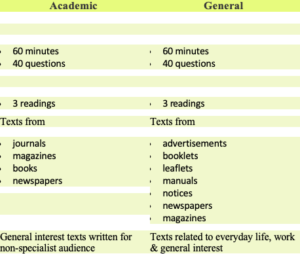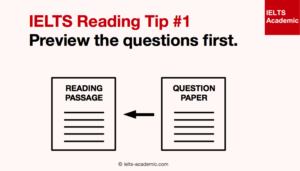On the off chance that you are taking IELTS to concentrate abroad, at that point you will take the Academic IELTS Reading Module. So read the Format of The IELTS Reading Test.
In the event that you are taking IELTS for different purposes, for example, working abroad, at that point you will take the General Training Reading Module.
In any case, improving your reading for IELTS is significant as you will confront some intricate reading and troublesome jargon.
Module of IELTS Reading
About the Reading Test
Both IELTS Reading Tests, Academic and General Training, expect to evaluate the accompanying aptitudes:
- Reading for gist
- Reading for main ideas
- Reading for detail
- Understanding inferences and suggested meaning
- Recognising a scholar’s suppositions
- Attitudes and reason
- Following the improvement of an argument
The tests change in their substance:

Format of The IELTS Reading Test
The Academic IELTS Reading Module

follow this pattern
The Academic IELTS Reading Module takes an hour and there are 40 questions to reply. Each question is worth 1 mark.
The Reading Passages
There are three reading passages with an aggregate of 2,150-2,750 words. Writings are taken from diaries, magazines, books, and papers.
All the points are of general intrigue and the writings have been composed for a non-specialist audience. The readings are planned to be about issues that are proper to competitors who will enter postgraduate or college classes.
In any event one content will contain definite legitimate argument. One of the writings may contain non-verbal materials, for example, charts, outlines or graphs.
On the off chance that there are specialized terms which you may not know in the content then a glossary is given. The writings and questions become more troublesome through the paper.
The Questions
Guidelines are clear and simple to follow and you will be given instances of any new question types. Messages and questions show up on a Question Paper which you can compose on however not detract from the test room.
You should address all questions on an Answer Sheet during the hour – there isn’t additional time toward the conclusion to move your responses to an answer sheet.
The position of the question changes- a portion of the inquiries may precede an entry, some may come in the wake of, depending on the question type.
These are the sorts of question you can hope to find in the test:
- short-answer questions
- multiple decision
- sentence culmination
- notes/outline/graph/stream diagram/table culmination
- choosing a heading for a section
- identification of author’s perspectives/claims – truly, no or not given
- identification of data – true, false or not given
- classification
- matching records/phrases.
There is an answer sheet and you should enter all the questions on there during the test. There is no additional time toward the conclusion to enter the scores. So read the tips of IELTS Reading Test.
Refer to the Format of IELTS Listening Test.


Recent Comments